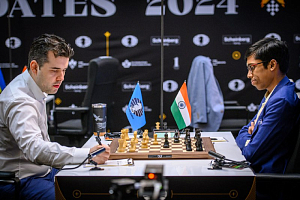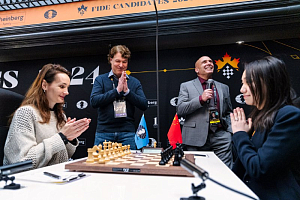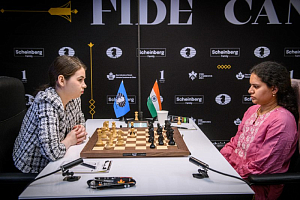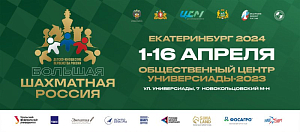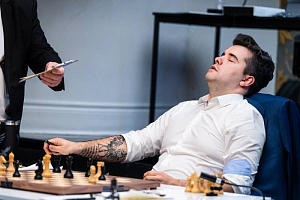17 May 2015
Nobody expected the c-pawn
Vladimir Barsky tells about the third round of the FIDE Grand Prix.
Two decisive games, two clever early stage novelties for White – on the 8th move and on the 6th move, and a new plan for Black in a fashionable (also in amateur chess) scheme of the King's Indian Opening – a good day all in all! On a flip side, there was a short draw, which took only an hour from both players combined, and we will start our report with it.
Nakamura-Giri draw
The American grandmaster selected an ancient line of the Italian Game, trying to catch his opponent unprepared. White sacrificed two pawns for quick development and central pressure. Anish Giri responded very logically and accurately: he returned both pawns one by one, forcing White to transpose to an equal ending. Soon the players began to repeat moves and agreed to a draw.
Nakamura: “I looked this line for someone else who is obviously much weaker, and then I decided to try this idea here. I thought maybe it is not easy to find all the right moves over the board, but Anish played it very correctly.”
Giri: “There are three reasons why I know this line. First of all, I saw some article by, I think, Smerdon. Usually I read his articles because they are funny. This one probably wasn't funny, but at least I learned something. Another reason is that once I had this line in an online blitz game. And the third reason is that a friend of mine recently recorded video series on sidelines in the Italian, so I was up to date even in insane lines like this. I guess I was even more educated than Hikaru.”
Tricky Nakamura and educated Giri
Karjakin-Dominguez draw
Typically in the King's Indian Opening White advances his pawn to e5 and tries to create a kingside attack, while Black looks for chances on the opposite flank. The Cuban grandmaster carried out the standard plan with his pieces arranged in a very non-standard way, which made his opponent think a lot early in the game.

“I guess he knew this line much better than I, but I was very happy to find the 15.с4!? idea. Yet, after 15…Ne7 Black turned out just fine.” (Sergey Karjakin)
Lenier Dominguez explained that he wanted to retreat the bishop to f8 to overprotect the h-pawn and defend against White's standard sacrifice on h6. The Cuban played in a similar way earlier against Grischuk, however, in that game his kingside rook developed to e8, and here he moved it to c8.
After a double exchange on c4 in turned out that Black's queenside counterplay is sufficient to balance the game. White was unable to rearrange his pieces properly and launch an attack. Karjakin decided to simplify the game by trading all rooks, and the players agreed to a draw on the move 30 in a complicated but seemingly balanced position.
Grischuk-Vachier-Lagrave draw
Alexander Grischuk declined an invitation to discuss the main lines of the Najdorf – a pet system of the French grandmaster, and opted for a relatively rare 5.f3 line. Vachier-Lagrave reacted in the most principled manner, pushing the d-pawn all the way to d4, where it impeded White's development. However, after с2-с3 followed by exchange on d4, Black's d-pawn became a weakness.
Soon after the opening White could win this pawn, however, that would give Black serious compensation thanks to his powerful bishop pair. Grischuk played more cautiously and obtained only a small plus. Vachier-Lagrave's energetic play on the queenside forced significant simplifications, and soon after the control the players agreed to a draw in an endgame with opposite-colored bishops.
Peter Svidler and Alexander Grischuk
Jobava-Gelfand draw
As Baadur Jobava told at the press-conference, he prepared this new idea 5.Qa4+ and 6.Qa3!? exclusively for this tournament. He added: “The computer does not rate White's chances highly, but this position is very complicated and not easy to handle. White has a simple attacking plan, while Black must play carefully in order not to get mated.”
Boris Gelfand: “White's new idea is very interesting! I think I reacted in the most principled way, but later probably made a mistake, which forced me to sacrifice a piece. Perhaps White could create more problems for Black, but I guess there was nothing that I could not solve.”
Black got two strong passed pawns on the queenside for a knight. In addition, White's pawn on a2 was weak, and he lacked piece coordination. In the forthcoming lively game the players showed great resourcefulness and creativity.
“And then Baadur made a mistake, and Black got an advantage. In the final position I probably could continue playing for a win, but I was so shocked because of everything what happened in our game, that we agreed to a draw.” (Gelfand)
Evgeny Tomashevsky and Fabiano Caruana
Caruana-Tomashevsky 1-0
The overall leader of the Grand Prix suffered his first defeat in this series. Tomashevsky had difficult positions several times in the previous tournaments, but he was lucky to survive every time.
Fabiano Caruana: “Today I decided to play the variation Evgeny knows very well, because we found an interesting idea – 8.g4!”
Evgeny Tomashesvky: “I haven't checked this line for a while, and the opponent's aggressive approach surprised me quite a bit. It is not easy to struggle over the board, especially when you know that Caruana examined everything very deeply at home.”
According to the Italian GM, White got a very pleasant game after the opening. Black lacked space and real counterplay ideas. White weaken the shelter of Black's king, broke through in the center and went for a direct attack. Tomashevsky defended tenaciously. “I don't think my position was that desperate, but it was hard to hold it under the time pressure”, concluded the Russian.
With series of exchanges White obtained a powerful passed pawn on e-file and focused on trying to promote it. Caruana confessed that he had a quick panic attack on the 35th move, when he intended 35.Rg3 with the idea of 36.Rexe6+, but then discovered 35…Kh8! Yet, he was able to find 35.Rd8 bxa4 36.Qe3, which gave White a winning advantage.

Jakovenko-Svidler 0-1
Facing the Ruy Lopez, Dmitry Jakovenko went for the Exchange Variation. Peter Svidler said that after his recent game with Rustam Kasimdzhanov he spent a lot of time analyzing this scheme, but failed to come up with something really solid. And White indeed for a small but stable advantage.

Dmitry Jakovenko: “I guess I played normally up to the 21st move, and then I totally overlooked 21…c5.”
Peter Svidler mentioned that the opponent surprised him with 20.Ne2, which looks rather odd, but is actually a good move. White would enjoy some advantage after 21.f5, while after 21.с3? с5! the tables has been turned: Black won a pawn and got a very strong bishop. Looks like White could force a draw by playing 29.Re8+ Kd7 30.Rf8 instead of 29.h3. After the move in the game Black got good winning chances.
Later in the game White did not defend in the most accurate way. For instance, Jakovenko said he blundered the idea 35…с4 followed by 36…Rb5, which gave Black's rook access to the queenside. Svidler continued to pile up pressure and eventually broke through the opponent's defense.
* * *
After three rounds three players collected 2 points – Lenier Dominguez, Fabiano Caruana, and Peter Svidler. Evgeny Tomashesvky is half a point behind.
Photos by Vladimir Barsky












